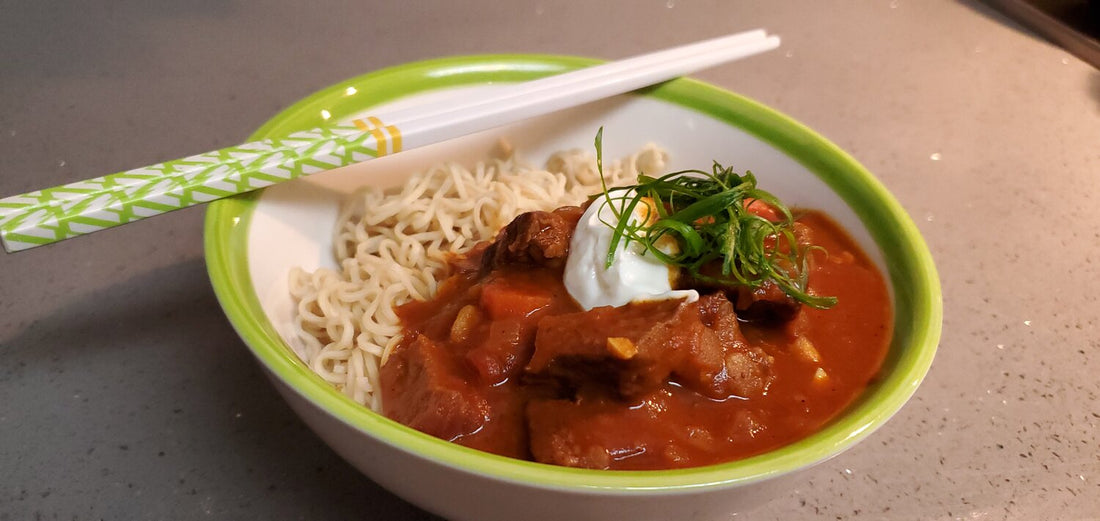
Naked Noods Beef Goulash
Share
Broth
- 3 Cups Beef Broth
- 1/2 Cup Hungarian Paprika
- 28oz Canned Tomato
- 1 1/2 Tablespoon Salt*
- 1 Tablespoon Pepper*
- 1 Tablespoon MSG*
- 5 Scoops Nanoboost
*more or less to taste
Meat & Veggies
- 3lbs Beef Chuck or other stewing meat
- 3 Carrots, Chopped
- 1 tsp Caraway Seed
- 3 Potatoes, Cubed
- 2 Bay Leaves
- 12 Cloves Garlic, Chopped
- 3 Large Onions, Sliced AND Diced
- Cut beef chuck into large portions, removing any excess fat or silverskin. DO NOT cube yet.
- Sear beef in pot with 1 Tablespoon of neutral oil, getting a good brown on all sides.
- Remove beef from pot and reserve. Cut into bite size cubes, about 1/4th inch, when cooled.
- Without cleaning the pot add the garlic, cook it until fragrant and floral (when it starts to smell good), then add in the onions. Sautee on high until somewhat translucent (usually takes about 3 minutes).
- Add paprika, caraway seed, salt, pepper, and MSG. Toast the spices while continuing to cook the onions until they're reduced in size by a little more than half.
- Add canned tomato, breaking apart the tomatoes with a wooden spoon or similar utensil. Then add in the carrots, cubed beef chuck, potatoes, beef broth, bay leaves, Nanoboost, and stir it all well.
- Simmer uncovered on low for 1 1/2 hours, or until beef is tender and soft.
- Optional: For a THICCER stew, mix together 1 tsp of cornstarch with 1 tsp of COLD water 10 minutes before it's ready to serve and add it to the stew. Repeat as many times as needed until desired THICCness is achieved.
- Season it to your own tastes, REMOVE BAY LEAVES, and serve alongside some noodles, rice, or bread!
The best thing about goulash is that it keeps really well in the fridge and works wonderfully as something that can heat up real quick in the microwave and be tossed in with anything! One of the reasons I especially like Naked Noods with this is that if you’re anything like me, the meat and veg ALWAYS go before the rest of the soup or stew is gone, so noodles are a fantastic way to eat the rest of it without wasting anything.
This is a family sized version-- If you’re looking for individual sized portions, then you’ll have to do some math, but since it keeps well as a leftover making more at once is better, in my opinion. There’s 5 scoops of Nanoboost for added nutritional density, but you can adjust it depending on how many portions you plan on making this. I realize I probably eat much larger portions than the average person, so your mileage may vary!
This stew is Hungarian-ish because it’s pretty much a Hungarian style goulash instead of the American style, but also I’m not going to say it’s completely accurate, especially since I intend to serve it with noodles, which makes it more American, but it’s asian noodles, so... y’know. Take from it what you will.
Hungarian Goulash tends to use fewer ingredients, not incorporate a staple carbohydrate like pasta in, and uses big ol’ chunky beef hunks instead. The American version, generally speaking, uses ground beef and some kind of pasta. Since the intended staple carbohydrate here is Naked Noods, then... well... we got ourselves a Hungarian-ish Goulash.
— Tim
As for almost all meats I’ll ever cook, I prefer to do a two step cooking process, keeping it in a larger chunk to get a better sear on it without overcooking the meat. The browning, also known as the maillard reaction, is what gives us a fantastic, intense flavor that you can’t get any other way, so it’s pretty essential in any dish. Especially since this is a stew that’s going to cook slowly over a long period of time, we know we’re going to be able to cook it through, so my main worry is always going to be how good of a sear I can get.
I’ve seen some articles say you’re setting the meat aside to rest so it retains more juices, but that’s not technically correct for a stew like this. Normally, we let meat, specifically things like steak, rest so that the proteins relax and retain more of their juices. This doesn’t really apply here as when we keep cooking it in the stew, the higher temperature(above 160F) will cause the proteins to denature and squeeze out the juices anyway, but also squeeze them out into our stew. Basically, this is just a really long way to say that the resting period is more about not burning your hands, so no need to think too much about it. Also make sure you put those meat juices into the stew. Yum.

Remove beef from pot and reserve. Cut into bite size cubes, about 1/4th inch, when cooled.
As for almost all meats I’ll ever cook, I prefer to do a two step cooking process, keeping it in a larger chunk to get a better sear on it without overcooking the meat. The browning, also known as the maillard reaction, is what gives us a fantastic, intense flavor that you can’t get any other way, so it’s pretty essential in any dish. Especially since this is a stew that’s going to cook slowly over a long period of time, we know we’re going to be able to cook it through, so my main worry is always going to be how good of a sear I can get.
I’ve seen some articles say you’re setting the meat aside to rest so it retains more juices, but that’s not technically correct for a stew like this. Normally, we let meat, specifically things like steak, rest so that the proteins relax and retain more of their juices. This doesn’t really apply here as when we keep cooking it in the stew, the higher temperature(above 160F) will cause the proteins to denature and squeeze out the juices anyway, but also squeeze them out into our stew. Basically, this is just a really long way to say that the resting period is more about not burning your hands, so no need to think too much about it. Also make sure you put those meat juices into the stew. Yum.

You’ll notice that I did something kinda funky with the onions, both slicing and dicing them, and not just because I was obsessed with ninjas as a kid or because I want to practice knife skills. Slicing an onion versus dicing an onion imparts different flavors and textures into the stew-- Specifically, a sliced onion will hold together better in the stew so that when you’re taking bites of the stew, there are actual pieces of onion that really gives a good onion-y flavor. The diced onions, on the other hand, will really cook down and almost melt into the stew and instead impart their flavor more evenly throughout. This technique allows you to use a single ingredient, onions, and create two different textural and flavor profiles, which is a concept that I really enjoy doing.


Adding the spices along with the onions and garlic will let them toast and cook, which gives them a stronger, more fragrant flavor. You can skip this step if you’re lazy, but it’s really nice to add another layer and level of flavor in.


After that, it’s a pretty simple matter of just throwing everything in there and letting it cook down. Make sure you’re watching the pot and stirring every so often so nothing burns. As it cooks down and reduces water, you might need to turn down the heat as well as there’s just less stuff in there overall. I’ve personally ruined many a stew by letting it simmer for hours and then having it burn because I wasn’t checking how hard it was simmering or boiling as it reduced down.

The one and a half hours of recommended cook time is pretty variable, depending on how you like your beef. Generally speaking, the lower your heat and the longer the time, the better it’ll turn out, so if you have time, I’d let it cook longer. You CAN’T achieve this by going hot and fast-- The gelatin, collagen, fats, and other connective tissue need time to hydrate, and you can’t do that with just a higher heat. It’ll just overcook things and make your meat tough.
You can use a roux or flour mixture to thicken the stew as well, I just find cornstarch slurries easiest. Also, make sure you remove the bay leaves. Having a nice big bite and then chewing on some bay leaves is never fun.

Hope you enjoy this recipe, and as always, let us know what you think and what you’d like to see next!





